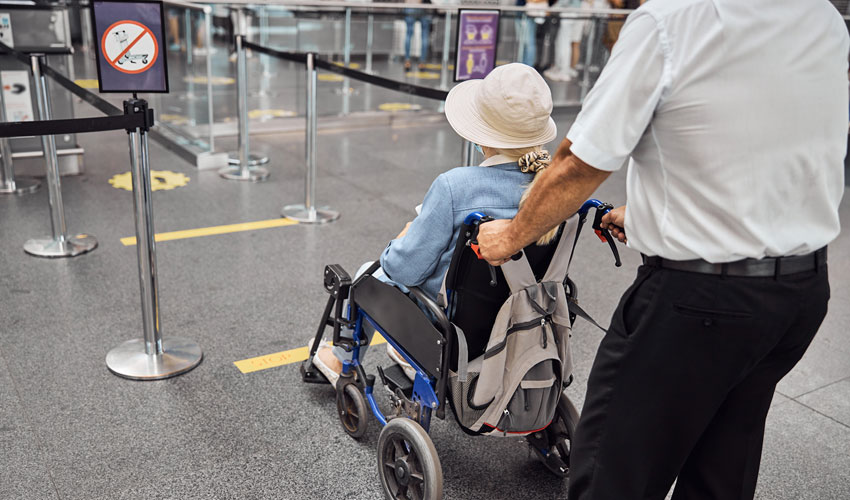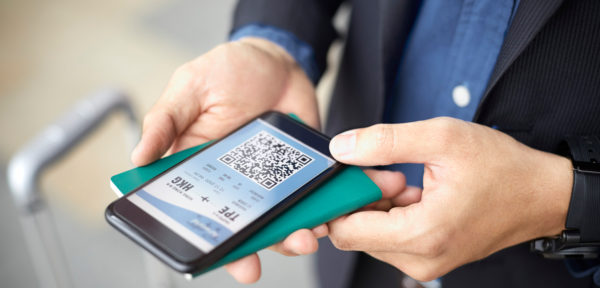Making air travel accessible for all individuals has been an industry priority for years. The provision of care services is not only time-consuming, but also demands a certain level of personalization. The result is a very labor intense process for which qualifications are crucial to provide the best quality aid possible. Depending on their health needs, passengers with restricted mobility (PRM) may require assistance that implies direct contact with care personnel. This poses new challenges for providers of passenger special services as social distancing and other protective measures must be enforced. Therefore, the industry is leading efforts in introducing new processes and technologies to enable a safe flight.
Adapting passenger special services to the New Normal
According to a survey of 238 people with special requirements, 33% of the respondents answered they would not travel by air until the vaccine is fully available. On the other hand, 38% said they may return to the skies before a vaccine´s full rollout. Factors defining the willingness to fly included:
- The levels of air circulation inside the passenger cabin
- Access to seats despite space dividers
- Staff availability to aid their journey
- Extra reassurance when passenger numbers start ramping up
- Clear communication of health protocols as they vary from region to region
Addressing these concerns is paramount to make passengers with reduced mobility (PRM) feel comfortable traveling again. Equally important is to consider the risk level of the country of operation before changing the traditional execution of passenger special services. Then, new procedures must not compromise the security and safety of crew, ground staff and travelers themselves.
Enhanced queue management
Following IATA´s recommendations, airports and airlines should develop specific procedures to ensure safe airport navigation and boarding. To comply with physical distancing requirements, PRMs could be assigned a dedicated queue. Moreover, to limit their COVID-19 exposure, operators may consider allowing a family member to accompany them. When possible, travelers might prefer to move around the airport independently. In any case, staff trained for passenger special services should actively follow-up on their journey and be ready to promptly provide them further assistance when needed.
For successful queue management, frontline managers must remain agile when the unexpected occurs. If additional dedicated queues are required, the access to real-time resourcing information is paramount. Optimization software can facilitate an efficient allocation of counters, by suggesting which check-in desks should open following the most cost-efficient option. In just a few steps, adequate spacing between queueing travelers can be achieved.
Wearing appropriate personal protective equipment
Within passenger special services, processes like lifting, boarding and de-boarding could make maintaining physical distance challenging. Therefore, the correct use of personal protective equipment (PPE) is of utmost critical. This means, assistance should only be provided if adequate gloves, masks, and hand sanitizers are on hand.
In the case of equipment, for instance, to transport wheelchairs, PRM handling companies should consider enhanced sanitization procedures. It is highly recommended that surfaces be sterilized after each use. The frequency can also vary depending on the region where the airline operates. If the area is considered high-risk, then cleaning protocols might include some advanced sterilization techniques.

New technologies for a touchless travel experience
The use of contactless technology is not new in the aviation industry. However, the pandemic is set to foster its deployment to keep passengers and personnel safe. Mobile payment solutions enable travelers to order and pay for food and beverage before arriving at the airport. Biometrics and self-check-in kiosks help speed up processing times at critical touchpoints. The challenge for the coming months will be to adapt these advancements to the new requirements within passenger special services.
Standard procedures and open communication
Regardless of the final destination, people with special requirements will expect a consistent level of accessible conditions throughout their journey. The Coronavirus has impacted cities around the world in different ways. It is reasonable to think then, that safety approaches will vary according to the pandemic evolution. However, airlines, airports and governments should strive to apply international standards where possible. A lack of a common framework affects travelers´ confidence as it generates much misinformation.
Proactive communication should be a great focus for companies providing passenger special services. Ensuring access to real-time updates on flight itineraries and risk mitigation mandates is as fundamental as guaranteeing full access to aviation facilities. By doing so, stakeholders will set the path to develop an inclusive COVID-19 recovery strategy.
Defining strategic goals for optimal passenger special services
Today, the provision of assistance to travelers with specific requirements poses new challenges. To better assess the situation, providers of passenger special services should first understand how the pandemic uniquely impacts their travel experience. That includes to what extent processing times will increase as they pass through enhanced security controls and pre-flight tests.
From a time and cost perspective, innovative technologies have the potential to bring several advantages. When looking at physical distancing, for instance, this measure may threaten operational efficiency at some point. By broadening the use of self-service kiosks, operators are one step ahead of achieving their safety goals, while maintaining a reasonable performance.
Another defining factor to optimize passenger special services is the thorough planning and allocation of resources. In times of reduced capacity, it is essential that staff and equipment are utilized as efficiently as possible. IT-solutions facilitate the management of assistance requests based on resource availability. Their functionalities may range from on-time dispatching of personnel and equipment, to enhanced task structuring. For a more decentralized work, employees receive all relevant data from existing airport systems directly on their mobile devices.
Enabling the best flight experience starts with the people providing the care service. It is crucial that staff is aware of appropriate responses to PRMs´ new concerns and expectations. Showing empathy, using less intrusive measures, and keeping the best attitude when questions arise can generate a comfortable traveling environment. Training and communication are the pillars for successful passenger special services.





0 comments on “Passenger Special Services: How to Make Air Travel Accessible in the New Normal”